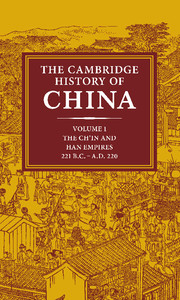Book contents
- Frontmatter
- Introduction
- 1 The state and empire of Ch'in
- 2 The Former Han dynasty
- 3 Wang Mang, the restoration of the Han dynasty, and Later Han
- 4 The conduct of government and the issues at stake A.D. 57–167
- 5 The fall of Han
- 6 Han foreign relations
- 7 The structure and practice of government
- 8 The institutions of Later Han
- 9 Ch'in and Han law
- 10 The economic and social history of Former Han
- 11 The economic and social history of Later Han
- 12 The religious and intellectual background
- 13 The concept of sovereignty
- 14 The development of the Confucian schools
- 15 Confucian, Legalist, and Taoist thought in Later Han
- 16 Philosophy and religion from Han to Sui
- Bibliography
- Glossary-Index
- Map 7 The Han empire, 143 b.c.
- Map 8 The Han empire, 108 b.c
- Map 9 The Han empire, a.d. 2
- Map 12 The Han empire, a.d. 140">
- References
2 - The Former Han dynasty
Published online by Cambridge University Press: 28 March 2008
- Frontmatter
- Introduction
- 1 The state and empire of Ch'in
- 2 The Former Han dynasty
- 3 Wang Mang, the restoration of the Han dynasty, and Later Han
- 4 The conduct of government and the issues at stake A.D. 57–167
- 5 The fall of Han
- 6 Han foreign relations
- 7 The structure and practice of government
- 8 The institutions of Later Han
- 9 Ch'in and Han law
- 10 The economic and social history of Former Han
- 11 The economic and social history of Later Han
- 12 The religious and intellectual background
- 13 The concept of sovereignty
- 14 The development of the Confucian schools
- 15 Confucian, Legalist, and Taoist thought in Later Han
- 16 Philosophy and religion from Han to Sui
- Bibliography
- Glossary-Index
- Map 7 The Han empire, 143 b.c.
- Map 8 The Han empire, 108 b.c
- Map 9 The Han empire, a.d. 2
- Map 12 The Han empire, a.d. 140">
- References
Summary
THE PATTERN OF POLITICAL HISTORY
The Han dynasty bequeathed to China an ideal and a concept of empire that survived basically intact for two thousand years. Before Han, imperial government had been experimental and it had become discredited; after Han, it was accepted as the orthodox norm for organizing mankind. Up to 210 B.C., if we may believe our sources, Ch'in imperial officials had enforced their will with some measure of harshness, severity, and oppression; by the first and second centuries A.D. emperors could command the loyal service of officials whose authority was subject to generally recognized standards of behavior. A centralized government, vested in a single emperor and his officials, had become respectable; and despite its weaknesses and failures, or the defeat of a Chinese empire by a foreigner, this form of polity was to remain unquestioned until almost the end of the nineteenth century.
This achievement – the acceptance of the imperial ideal – was accomplished partly by dynastic success and partly by deliberately fostering new political concepts. At first sight it is somewhat surprising that those concepts earned credence, in view of the difference between the practical expedients of administration and the ethical claims put forward on behalf of the imperial dispensation. As in Ch'in, so in Han effective government depended in the last resort on compulsion; but whereas the emperors of Ch'in and the first statesmen of Han had been content to justify their exercise of power in material terms such as the possession of territory and the success of arms, the emperors of Han were shortly to seek a moral and intellectual justification which would legitimize their rule in superhuman terms.
- Type
- Chapter
- Information
- The Cambridge History of China , pp. 103 - 222Publisher: Cambridge University PressPrint publication year: 1986
References
- 23
- Cited by

